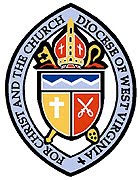1700s
Ministry of the Church of England and its successor, the Protestant Episcopal Church, developed slowly in what is now West Virginia. The 1784 disestablishment of the Church of England in the then-unified Virginia created severe challenges for Episcopalians. [5]
The first Episcopal Church in present-day West Virginia was established as a log structure in 1740 near Bunker Hill in Berkeley County. This chapel was founded by Colonel Morgan Morgan [6] and known by the names Christ Episcopal Church and Morgan Chapel. Services at Morgan Chapel were led by local lay readers and by occasional priests visiting from Christ Church in Winchester, Virginia. Morgan Chapel is maintained as a historical site, but worship services are now held in nearby Zion Episcopal Church, Charles Town. Zion Church was the spiritual home of Charles Washington, Col. Lewis Washington, and John Yates Beall. [7]
Westward expansion of white settlers in the late eighteenth century encouraged the founding of Episcopal Churches near the Ohio River. Unlike most Virginia churches, mountainous geography led many churches in West Virginia to be planted by congregations from Pennsylvania, Maryland, or Ohio. Mirroring Virginia politics, diocesan bishops based in Williamsburg and Richmond often overlooked Episcopalians living west of the Blue Ridge. Efforts of the Rev. Dr. Joseph Doddridge, a Pennsylvania-born missionary, were especially significant in establishing frontier churches in the Upper Ohio Valley. [8] In 1793, he founded Olde St. John's Episcopal Church in Colliers. [9] It remains the oldest continuously active Episcopalian congregation in West Virginia. [10]
1800s
In the absence of episcopal visitations from the bishop of Virginia, Bishop William White of Pennsylvania consecrated St. Matthew's Episcopal Church in Wheeling, West Virginia as the nineteenth century began. By 1851, Episcopalians in the northwestern mountain counties petitioned Bishop William Meade of Virginia to provide the mountain region its own bishop. Meade demurred even though he had previously founded St. John's Episcopal Church, Charleston, in 1837, and serviced these parishes both while affiliated with Christ Church, Winchester, and later as assistant bishop of Virginia. When John Johns became his assistant bishop, he likewise conducted periodic visitations into the western counties of Virginia. However, with the outbreak of the American Civil War, episcopal visitations ceased. In 1863, shortly before West Virginia's incorporation as a state, St. Matthew's Church, Wheeling, asked permission for another bishop to visit the parish, but like his predecessor, Bishop Johns demurred, asking instead for a safe-conduct to visit the area, which he did not obtain.
After the Civil War, the six northwestern counties remained part of the Diocese of Virginia for more than a decade. By 1876, Virginia's diocesan council (a name analogous to diocesan conventions elsewhere) agreed to support the creation of a separate diocese for the state of West Virginia, which the national General Convention approved in 1877.
At the organizational meeting led by Virginia bishop Francis McNeece Whittle (who chose to remain with the larger diocese), 14 clergy and 16 lay delegates agreed to extend an invitation to Rev. J.H. Eccleston of Newark, New Jersey to become their new bishop, but his existing congregation pointed out to him the missionary nature of the new diocese and questioned its ability to financially support a bishop and other diocesan officers, and he refused the call. The following year, the clerical and lay delegates met again and finally decided to call Rev. George William Peterkin, who accepted the call and was consecrated by bishops of Virginia, Maryland and Kentucky at the new diocese's largest church, St. Matthew's Church in Wheeling on May 30, 1878. [11]
Although the churches in Wheeling and Charleston had also offered to build rectories for the new bishop, Rt. Rev. Peterkin chose to accept the offer from the Parkersburg congregation. He thus made the town diocesan headquarters and ultimately succeeded in raising the funds and building the Church of the Good Shepherd in Parkersburg in 1891.

